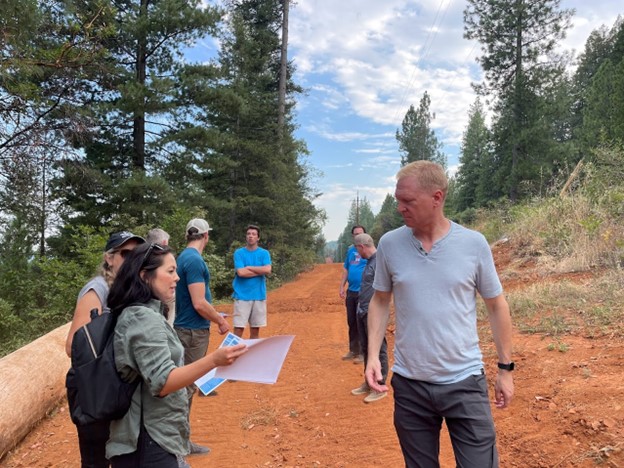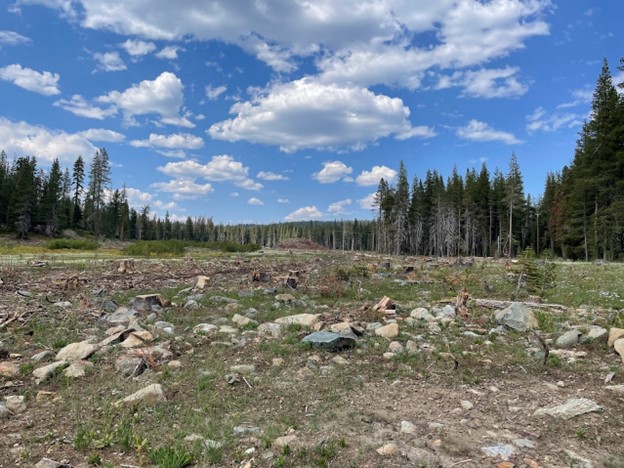
Helen Zhang and the Blue Forest Team on an FRB site visit
Site Visit: Forest Resilience Bond
September 30, 2022
The increase in catastrophic wildfires across the Western U.S. in recent years has emphasized the importance of protecting forest ecosystems—and nearby communities—by making them less prone to fire. Blue Forest Conservation developed its Forest Resilience Bond (FRB) to finance sustainable solutions to systemic climate challenges that disproportionately impact vulnerable communities. The bond deploys private capital to finance forest restoration projects on private and public lands that reduce catastrophic wildfires and enhance landscape resilience.
Calvert Impact Capital first invested in the Bond in October 2018 to help finance FRB’s Yuba Project I, a forest restoration project protecting 15,000 acres of forestland in the North Yuba River watershed using ecologically based tree thinning, meadow restoration, prescribed burning, and invasive species management. This summer, I had the opportunity to travel to Yuba and Sierra Counties in California and meet with the team behind the project in the heart of the forest where our capital is hard at work.
The Challenges of Restoration
As a result of the long-standing practice of fire suppression, or stopping smaller, environmentally beneficial fires, combined with climate change, the size and severity of wildfires has grown. The increase in fires has required increased funding for fighting the blazes, leaving less for efforts to reduce risk of fires before they begin. By removing overgrown vegetation that fuels wildfires and restoring native habitat, forest restoration is key to achieving healthy forest ecosystems and increasing the resilience of the communities that rely on the many benefits of forests, including clean water, air, and recreation.
During the site visit, the team shared just how complex reforestation is. It is an intricate, multi-step process that includes vegetation thinning, prescribed burns, invasive species removal, and planting native species. Without proper funding, these proactive land management activities cannot be conducted at an adequate pace, leaving western landscapes at high risk of continued catastrophic fires and threatened water supply.

Blue Forest Conservation’s Collaborations
Blue Forest Conservation is not the only organization working to restore healthy forests. Collaborations are an essential part of climate work, and large-scale projects are rarely accomplished without multiple actors. During the first day of the trip, we learned about the North Yuba Forest Partnership, a diverse group of nine organizations, including Blue Forest, passionate about forest health and the resilience of the North Yuba River watershed. The Partnership brings together financers like Blue Forest, local nonprofits, and restoration professionals like the U.S. Forest Service and the National Forest Foundation to make projects like Yuba I a possibility.
We also heard about Vibrant Planet, a start-up that harnesses data and cloud-based technology to help make communities and ecosystems more resilient in the face of climate change. The company’s SaaS offering, Land Tender, grew out of its consultation for the North Yuba Forest Partnership. The platform allows users like the U.S. Forest Service to prioritize their objectives like fire risk, endangered species conservation, or water quality, and run analyses to determine how different landscape treatments impact their priorities.
We ended the first day with a tour of a proposed site for Camptonville Community Partnership’s (CCP) biomass project, a collaboration between CCP and the Yuba Watershed Protection and Fire Safe Council, to develop a Forest Biomass Business Center (FBBC). The FBBC’s small power generation facility will transform wood into up to 5 megawatts of clean, renewable energy and support the local community. It’s a continuation of FRB’s current collaboration with the Honey Lake Power plant. After years of fire suppression, many forests are overgrown and dangerously dense. Through FRB funding, the National Forest Foundation has purchased and used machines to chop suppressed, diseased, and immature trees into small chips and transport them to the plant where they are burned for steam generation. To date, 8,500 green tons of biomass have been removed from the landscape. This biomass removal has provided a clean energy alternative to fossil fuels while reducing fire risks in rural communities.

Yuba Water Resource and Habitat Restoration Projects
The second day of the site visit focused on how FRB funding supports projects focused on sustainable water resource management and aspen meadow habitat restoration. The Yuba Water Agency manages water resources for flood risk reduction and reliable water supply maintenance in Yuba County, supporting the environment and quality of life of its communities. Water quality in the county relies heavily on the condition of the upper Yuba River watershed. Furthermore, because various homes and communities have been built within and near forests, many lives and properties are vulnerable to the damages of high-severity wildfire. Thus, Yuba Water Agency invested in the first piloted FRB which focuses on forest restoration work in the watershed, protecting residents, communities, and water supply.
Another Yuba I project we learned about was meadow and aspen grove restoration. Aspen groves are biodiversity hotspots, but as surrounding conifers encroach, their water demands alter the hydrologic processes of the meadow. This encroachment can dry out the ecosystem and hurt biodiversity levels. In cases of ecologically inappropriate tree growth, an effective restoration treatment is to remove the trees. Most of these encroaching conifers in Yuba I units are lodgepole pine, a species with almost no marketable value. FRB’s collaboration with Honey Lake Power, however, has given these trees a purpose. They are one of the main sources of woodchips for the plant’s clean energy program.

Impact of FRB
In 2021, 7.1 million acres of land were burned, resulting in $70-90 billion in total damage and cumulative economic loss during wildfire season in the U.S. By the end of 2021, Blue Forest Conservation had raised over $29 million for FRB forest restoration projects like the Yuba projects we learned about during the site visit. Together, Yuba I, which is in progress and is expected to finish in 2022, and Yuba II, which began in 2021, protect over 63,000 acres from severe wildfire. I left the site visit incredibly inspired by Blue Forest’s efforts and Calvert Impact’s supportive investments. I’m excited to work on future projects with them after learning about the catastrophic effects of wildfires on vulnerable communities and ecosystems.




